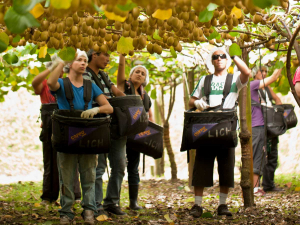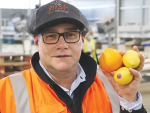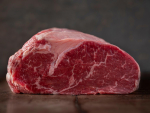Kiwifruit picking is underway in Gisborne and the Bay of Plenty, signalling the beginning of the 2020 kiwifruit harvest.
The 2020 season is forecast to be another very large crop with around 155 million trays of Green and Gold kiwifruit expected to be picked in orchards and packed in packhouses across New Zealand from Northland to Motueka. This year’s crop is forecast to be well up from the 147 million trays exported in 2019.
It is predominantly the Gold variety which is first picked, followed by Green kiwifruit in late March. The last fruit is picked in June.
Nikki Johnson, chief executive of New Zealand Kiwifruit Growers Inc. (NZKGI), says that consumers should expect the fruit to be tasting great. However, there are some potential hurdles around dry weather, Coronavirus and seasonal labour availability.
“As the kiwifruit is packed, we will start to have a clearer picture of the impact of this years’ hot and dry weather which may be influential,” says Johnson.
In addition to the dry weather, this season also has an emphasis on being well prepared for potential disruption from Coronavirus.
“As we are working with a food crop, the industry already has strong processes in place around food safety and personal hygiene and these will continue to be important. The industry is working together to plan and mitigate disruption and will be following public health recommendations”, says Johnson.
Based on the forecast volume and spread of the harvest season, it is currently forecast that around 20,000 workers will be required throughout the harvest period. However, Johnson says it will become clearer if there are sufficient workers as the industry gets closer to the peak of harvest and the requirement for significantly more seasonal workers increases.
NZKGI has taken proactive steps to mitigate the likely labour risk and will be communicating on the steps which will be taken over the coming weeks. In addition, NZKGI has been in conversations with forestry organisations to ascertain if there is the ability to provide opportunities to forestry employees while there is a lull in wood exports.
Zespri chief grower & alliances officer Dave Courtney says Zespri was expecting another great tasting crop with more SunGold than Green kiwifruit.”
“This year we’re again expecting to have more SunGold than Green kiwifruit, and of course we’ll be bringing an increasing amount of Zespri Red Kiwifruit to market following last year’s limited release.
“We’re also excited to introduce our new brand to consumers and progressively roll this out to markets across the year,” Courtney says.
The importance of New Zealand’s kiwifruit industry is represented through its contribution to New Zealand’s local economies, contributing $1.82 billion to kiwifruit growing regions in 2018.











